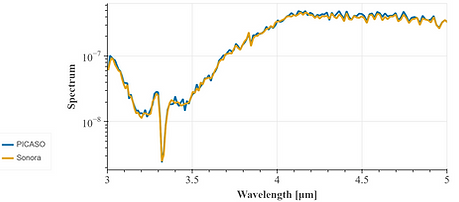top of page
Neural Network Accelerated Retrieval of Brown Dwarf Atmospheres
Keywords:
#Brown Dwarf #Atmosphere #Neural Network
This project focuses on advancing the study of substellar atmospheres by developing machine learning–based surrogate models for radiative transfer and retrieval. Brown dwarfs, with their complex cloud microphysics and broad temperature range, present a rich but computationally challenging laboratory for atmospheric modeling. Using the PICASO radiative transfer framework together with cloud microphysics from Virga, I am generating large spectral datasets to train neural networks that can emulate forward models at a fraction of the computational cost. These surrogate models will then be integrated into atmospheric retrieval frameworks like MARGE and HOMER, enabling faster and more flexible exploration of parameter space.

Credit: Natasha Batalha

Credit: Natasha Batalha
Spectral Data
I constructed a Python-based pipeline that loops across effective temperature, surface gravity, sedimentation efficiency (f_sed), and vertical mixing (Kzz) to generate grids of brown dwarf spectra. Each spectrum is re-gridded to constant resolving power to ensure consistent training data. Cloud microphysics are included using Virga, with condensate species automatically selected based on condensation curves. These outputs are stored as structured .npz datasets containing inputs (Teff, g, f_sed, Kzz) and outputs (flux spectra), serving as the foundation for neural network training.
Neural Network Surrogate
The spectral grids are being used to train neural networks that approximate radiative transfer models across broad parameter ranges.
By reducing runtime from minutes per spectrum to milliseconds, these surrogates make retrieval analyses more computationally feasible. I am testing different architectures and hyperparameter strategies to balance accuracy and generalizability, while also validating the surrogates against “ground truth” PICASO/Virga spectra. Early results show strong fidelity in cloud-free cases, with ongoing work focused on extending this to cloud-rich regimes.
Retrieval Integration and Scientific Goals
Once trained, these neural network surrogates will be integrated into MARGE and HOMER retrieval frameworks. This will enable rapid inference of brown dwarf atmospheric parameters from observational data, particularly in regimes where traditional radiative transfer is prohibitively slow. The ultimate scientific aim is to better constrain brown dwarf cloud properties, chemical abundances, and thermal structures, while also establishing a framework transferable to exoplanet atmosphere studies. By bridging physics-based modeling with machine learning, this project paves the way for next-generation retrieval pipelines that are both accurate and efficient.
This work is in progress, and updates will be posted here as new results and retrieval demonstrations become available.
bottom of page